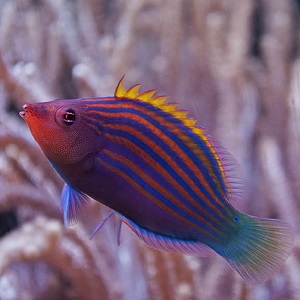Six-line wrasse is a marine ray-finned fish species, belonging to the Labridae family, indigenous to the Indo-Pacific belt. Mostly found in the coral reefs, this beautiful fish gets its name because of the six orange stripes running along its body. Pieter Bleeker, a Dutch ichthyologist, described it formally for the first time in 1857 as Cheilinus hexataenia. In certain parts of Thailand, the six-line wrasse is often collected by sea gypsies as their source of food.
| Scientific Name | Pseudocheilinus hexataenia |
| Other Names | Sixstripe wrasse |
| Origin | Tropical waters of the Central and Indo-West Pacific region including parts of the Red Sea, the northern part of Japan, north-western Australia, northern Great Barrier Reef, and northern New South Wales |
| Type | Freshwater fish |
| Conservation Status | Least Concern (by the IUCN) |
| Behavioral Characteristics | Peaceful especially if introduced to the fish tank last; active and curious, loving to wander around its habitat all day; displays a semi-aggressive behavior with other six-line wrasses mostly if living together in a small tank |
| School Size | 2 – 3 |
| Physical Traits | Small and slender body with a striped appearance; a false eye near the tail fin helping it to escape from predators by confusing them |
| Colors | Violet body having six orange stripes running horizontally; red eyes; orange cheeks with several tiny yellow dots; blue stripes on the anal fin; and steaks of blue with a combination of green and yellow on the caudal fin; |
| Size (How big do they get) | Small; 3.9 inches (9.9 cm) |
| Lifespan | Approximately 10 years |
| Sexual Dimorphism | Present; Males are bigger than the females also attaining a brighter coloration mainly during the breeding season |
| Probable Diseases | Ich and bacterial infections |
| Approximate Price (How much is it for) | $30 |

| Care Level | Beginner |
| Tank Size | 20 gallons (76 liters) for a single six-line wrasse |
Water Parameters
| pH Level | 8.1 – 8.4 |
| Temperature | 72 – 78 °F (22.2 – 25.5°C) |
| Hardness | 8 – 12 dGH |
| Aquarium Water Flow | Low, moderate or high ( no particular requirement) |
Tank Ambience
| Lighting | Moderate |
| Substrate Type | Live rocks, pebbles, and sand (for it to sleep and even cover itself if frightened) |
| Tank Mates | Compatible with: Species of angelfish, clownfish, dotty back, tangs, butterflyfish (when kept in a reef); goatfish, pufferfish, and squirrelfish (in a non-reef setup) Incompatible with: Other six-line wrasses, alongside members of the wrasse family like the leopard wrasse; lined seahorse, green chromis, and royal gramma; they could even be aggressive and attack crustaceans like cleaner shrimps and its species such as the peppermint shrimp as well as the hermit crab and snails |
| Suitable Position in the Tank | Anywhere (top, middle, and bottom) |
Feeding
| Diet | Frozen mysis and brine shrimp, flakes, and pellets |
| Frequency | 2 times a day |
The six-line wrasse is reef safe and does not eat corals and other invertebrates present.
The six-line wrasses are likely to bury themselves in the sand (if available) at night or may even sleep inside their mucus cocoon that they are known to spin.